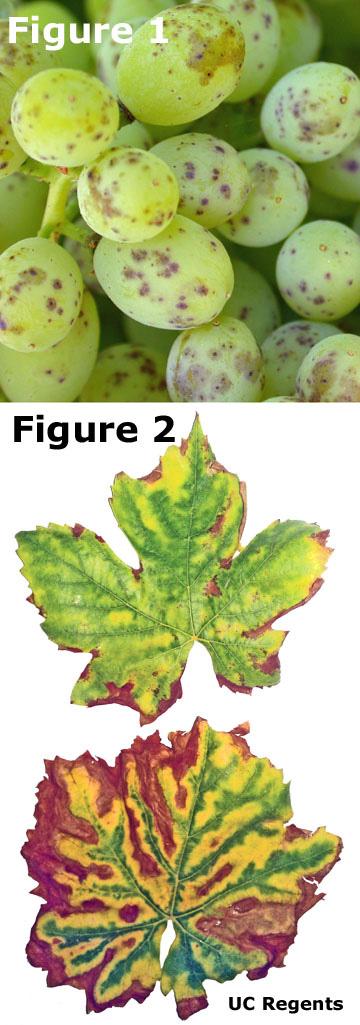Symptoms Causal Organisms Management More Information
Stephen Vasquez, University of California, and Matthew Fidelibus, University of California
Symptoms

Grapevine measles, also called esca, black measles or Spanish measles, has long plagued grape growers with its cryptic expression of symptoms and, for a long time, a lack of identifiable causal organism(s). The name ‘measles’ refers to the superficial spots found on the fruit (Fig. 1). During the season, the spots may coalesce over the skin surface, making berries black in appearance. Spotting can develop anytime between fruit set and a few days prior to harvest. Berries affected at fruit set tend not to mature and will shrivel and dry up. In addition to spotting, fruit affected later in the season will also have an acrid taste.
Leaf symptoms are characterized by a ‘tiger stripe’ pattern (Fig 2-bottom leaf) when infections are severe from year to year. Mild infections can produce leaf symptoms (Fig. 2-upper leaf) that can be confused with other diseases or nutritional deficiencies. White cultivars will display areas of chlorosis followed by necrosis, while red cultivars are characterized by red areas followed by necrosis. Early spring symptoms include shoot tip dieback, leaf discoloration and complete defoliation in severe cases.
Leaf symptoms can be found on canes with infected fruit; however, it is not uncommon for only the leaves or only fruit to show symptoms. Moreover, symptoms are not necessarily expressed every year. The most severe cases seem to occur in years with heavy spring rains, followed by consistently high summertime temperatures. In addition to the chronic symptoms that can plague a vineyard over its life, an acute expression of measles known as “apoplexy” can kill grapevines in a single year. Apoplectic grapevines will begin to grow normally until late spring or early summer after which they suddenly defoliate and abort their fruit. Grapevines rarely recover from apoplexy.
Cross sections through arms, cordons or trunks from grapevines displaying measles symptoms often ooze a dark sap when cut. The dark brown-black vascular streaking throughout the xylem (vascular elements that carry water in plants) is the result of phenolic compounds that begin to oxidize. Infected grapevines will also produce tyloses—outgrowths on parenchyma cells of xylem vessels—that help confine the movement of fungi responsible for the malady. Older grapevines displaying measles will also have numerous secondary wood-rotting fungi growing within the wood.
Causal Organisms
Recently, two genera of fungi have been implicated as the cause of measles and grapevine decline, a disease that affects young vineyards. Phaeomoniella chlamydospora and Phaeoacremonium spp. fungi have been isolated from vines displaying symptoms throughout vineyards in the U.S. Grapevine pruning wounds and natural cracks located on the trunks and cordons have been found to be populated with perithecia (fungal reproductive structure) that resembled Togninia, the teleomorph (sexual stage) of related species within Phaeoacremonium spp. Identifying the causal organisms has brought researchers and growers closer to identifying a disease cycle and management program but measles continues to cause economic damage to grape production worldwide.
Management
Presently, there are no effective management strategies for measles. Wine grape growers with small vineyards will often have field crews remove infected fruit prior to harvest. Raisins affected by measles will be discarded during harvest or at the packing house, while table grape growers will leave affected fruit on the vine. Current research is focused on protecting pruning wounds from fungal infections to minimize suspect fungi from colonizing fresh wounds.
Recommended Resources
Grape Measles, University of California
Esca and Petri Disease of Grapes (pages 1 and 2), University of California
Reviewed by Damon Smith, Oklahoma State University and Stephen Jordan, University of Wisconsin-Madison
